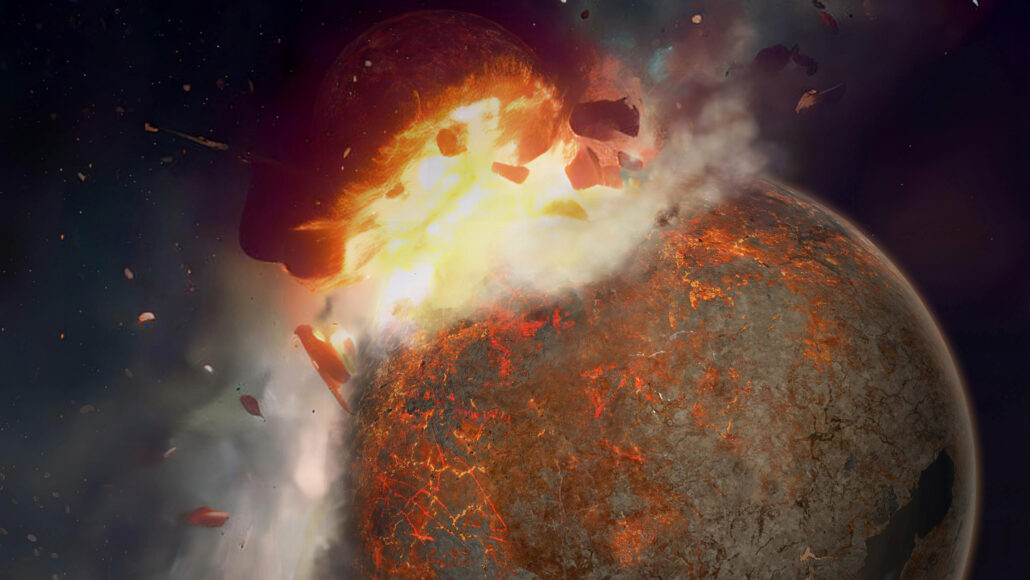Earth’s Mantle May Still Contain Rock from Moon's Formation Impact

Approximately 4.5 billion years ago, the young Earth was hit by a Mars-sized object, scientists believe. This impact resulted in a vast amount of debris which came together to form the moon. Some believe that the remnants of the impactor, named Theia, continue to exist in the form of dense material situated above Earth's core. This theory was proposed by researchers on November 1 in Nature.
Recent studies have revealed large areas of rock at earth's mantle-base displaying extraordinary characteristics; seismic waves travel through these areas at a slower speed, therefore it's believed that these rocks possess a higher density than the rest. Such rock formations, identified as large low-velocity provinces, can be found under Africa and half a world apart, beneath the Pacific Ocean, as mentioned by planetary geodynamicist Qian Yuan from Caltech.
Earlier theories proposed that these masses might be leftover fragments of tectonic plates which were pushed below others and ended up sinking to the boundary of Earth's outer core and the mantle above it. However, Yuan and his team present a different theory.
The moon constitutes about 2 percent of Earth's mass, meaning there is a significant amount of Theia that is yet to be accounted for. The researchers managed to analyse the aftermath of a potential collision between the young Earth and another object, using supercomputer simulations.
It was simulated that before the impact, both celestial bodies possessed a dense core of iron surrounded by lighter rock material. Each object was digitally divided into particles approximately 10 kilometers in size, allowing the fragments produced by the collision to be monitored," says co-author of the study, Vincent Eke, a computational physicist at Durham University, England. The team's simulations followed the journey of about 100 million particles.
The simulations hint that a significant part of Theia's core, which could be as much as 3 percent of Earth's current mass, was left on our planet and would have sunk towards Earth's core following the impact. Simultaneously, a substantial quantity of Theia's mantle, perhaps equal to 5 percent of Earth's mass, was incorporated within the Earth's uppermost 1,400 kilometers of mantle.
According to moon rocks, it is plausible that Theia's mantle held a higher presence of iron oxide minerals. This suggests that it was probably a few percent denser than the Earth's mantle, as per Yuan. In the tens of millions of years that followed the collision, this denser material slowly descended to constitute large low-velocity provinces, the researchers hypothesize.
There are many theories regarding these low-velocity provinces. Some believe they are remnants of tectonic plates, while others have suggested they are the high-density leftovers of Earth's initial magma ocean which sunk to the deepest levels of Earth's mantle. Paul Tackley, a geodynamicist at ETH Zurich, observed that the recent attribution of these provinces to the material left after Theia's collision with the young Earth is a novel concept. He was not part of this research.
Regardless of Theia's accidental role in the origin of the low-velocity provinces, Tackley believes it's plausible that they could have persisted for nearly 4.5 billion years since the formation of the moon. He suggests that if the material in these zones was dense enough to avoid blending with the overlying mantle over time, it could survive over a geological time scale.
The predominant theory of how the moon was formed, known as the "giant impact hypothesis," involves a collision between Earth and a protoplanet. In the past, researchers proposed that such a collision could explain the subtle differences between the elemental composition of the moon rocks and those from Earth. Moreover, a recent theory also posits that a collision between the young Earth and Theia could have initiated plate tectonics.
This article was made possible by the contributions of our readers. Support quality science journalism by donating today.




